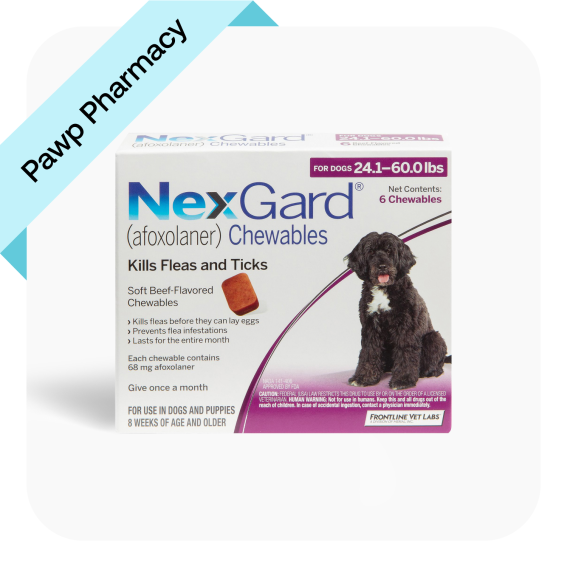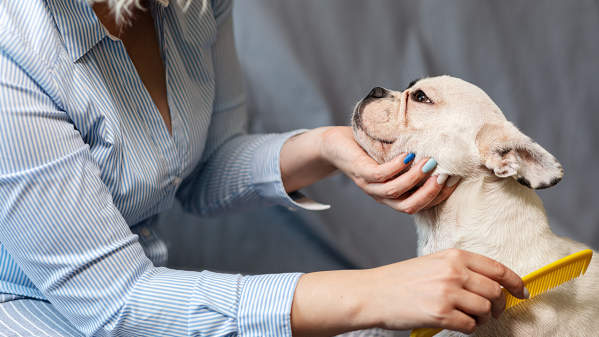Every pet parent knows that there are some challenges that come along having a furry friend—like when your pet is dealing with fleas.
Handling fleas—and even worse—a flea infestation, can be extremely difficult, so knowing how to properly remove fleas from your pet before they become pervasive can make all the difference.
In addition to learning how to safely remove fleas, it's also imperative that you understand where they come from in the first place and what you can safely give your pet to prevent them in the future.
“A lot of the products available on the market for fleas can be dangerous for your pet,” says Dr. Jo Myers, DVM. "In order to avoid wasting time and money, it's best to get some professional advice when building your flea elimination or prevention strategy.”
How do dogs and cats get fleas?
Dogs and cats get fleas because they're present in high numbers in the vast majority of places where pets and people live. They're so ubiquitous that you're essentially guaranteed to have a flea problem if you don't do something to prevent it in most geographic regions.
People may assume that if their pet rarely goes outside, they won't get fleas. However, the reality is that fleas can impact an indoor pet, too.
It's true that one of the most common ways that dogs and cats come in contact with fleas is when they go outside to play or walk. Pets can also catch fleas from other animals. So while your indoor cat is less likely to pick up fleas, it can still happen.
“A cat on a garden-level apartment can still get them directly from the environment, especially if he goes out on a balcony or has access to the outside through a screen,” explains Dr. Myers. “A strictly indoor kitty living in a high-rise penthouse is at really low risk for fleas, but can still get them if a previous resident or neighbor had them, even if the apartment has been empty for as long as a year.”
Where do fleas live?
Fleas tend to live in undisturbed areas with good hiding places, and can be found anywhere outside.
The problem with fleas is that they are able to jump—up to seven inches, in fact. They jump onto a host to mate and lay eggs, but then jump off again after that.
While it’s true that environments with a lot of cats, rabbits, squirrels, or critters are likely to carry a much larger population of fleas than places without any other hosts to support the flea population, it can be difficult to avoid fleas while you’re outside. You can keep your whole house and yard super sanitary but still get fleas.
How to prevent your pet from getting fleas
You’ve heard the saying, “An ounce of prevention is worth a pound of cure.” It’s worth your time to prevent your pets from getting fleas, as they can be itchy, irritating, and immensely difficult to get rid of.
Give your pet preventative flea medication
Fortunately, there are a variety of safe and effective forms of flea control on the market. The hard part is knowing which ones actually do what they claim and which ones can even be dangerous. That's why it's best to consult a veterinary professional before deciding what's best for your situation.
“Navigating the right choice for a flea control product is best done with professional guidance,” says Dr. Myers. “There are a lot of variables: geography, climate, household environment, other pets, health status, and budget.”

NexGard Chewable, 24.1-60 lbs, (Purple Box), Rx$30
If you're a Pawp member you can purchase your flea and tick medication through the Pawp Pharmacy. You will already need to have a prescription.
Do regular fur and skin checks
As a pet parent, it’s essential that you do regular checks on your dog or cat for fleas. A quick Google search of “fleas” will help you understand what these parasites look like. Warning—they're not so cute to look at.
With a brush, comb, or your finger, run through your pet’s fur. It’s most important to check your pet around their tail, neck and collar area, in the back of the rear legs, and in the groin/belly area. Keep an eye out for small black specks, suspicious hair loss, itching, and scratching (which could indicate flea bites).
How to get rid of fleas on dogs and cats
While prevention can go a long way, sometimes things are just out of your control and your pet finds themselves in an itchy situation. If your dog or cat has fleas, there are remedies that can help. If you take swift action, you can eliminate the odds that it will become a full-on infestation in your home.
Talk to a veterinarian
The first thing to do is to talk to a veterinary professional so you don't waste time and money on something that isn't going to work or may even be harmful to your pet. Pets die every year from flea products, even when their pet parents had the best of intentions.
It's also helpful to talk to a veterinary professional so you know what to expect from flea treatment and prevention.
The prescription flea products available from your vet are the safest and most effective options available. They come with the added benefit of a veterinary professional who can explain how to use it correctly as well as address how the particular product will fit into your unique lifestyle as well as your pet's health status.
A note about natural remedies and essential oils
Essential oils are often celebrated for their ability to help and heal. However, it's critical to note that these aids can be dangerous to pets.
“While these types of products are popular, they are not effective. In order to avoid wasting money and putting your pet at risk, it's better to choose an option that has scientific evidence to prove its safety and efficacy," says Dr. Myers.
And yes, essential oils can be very toxic to pets, especially cats.
Use a vet-recommended form of environmental treatment
Unfortunately, nothing can kill flea eggs. This is why it takes so long to eliminate a flea population.
There are oodles of eggs and new ones are laid every day, even if you're doing your best to kill the adults and larvae. That's why it takes at least 3 months to get ahead of the population growth curve and eliminate the fleas.
“If you're using one of the state-of-the-art safest and most effective forms of flea control, it's actually possible to eliminate an entire flea population in your house without any sort of environmental treatment,” explains Dr. Myers. “That being said, it's still beneficial to carry out some sort of effective environmental treatment in order to hasten the elimination of the flea population.”
The only worthwhile forms of environmental treatment are:
1. Use an approved environmental spray that contains an IGR (insect growth regulator)
Most of the things you see for sale that are a "flea spray" are either hazardous pyrethrin- or permethrin-based chemicals or completely worthless "natural" products. The only worthwhile sprays are environmental sprays with IGRs that are not used on the pet.
Frontline Plus comes in a spray form and it's possible for that to be helpful in some situations, but it's not easy to use it correctly.
2. Vacuum and launder bedding frequently.
When you're trying to eliminate an existing flea population, it can be helpful to vacuum carpets and wash bedding, but the purpose of that is only to reduce the number of flea eggs and larvae in the environment. When you consider that fleas reproduce super fast in high numbers, this won't make much of a dent in the overall population, but it's still worth a try. You should also throw away the vacuum bag somewhere away from the house because the eggs in the bag can hatch and re-infest the area.
Eliminating carpet and bedding is also helpful.
Remember, even if you remove all the fleas from your pet, if the fleas are still on bedding, carpets, or other surfaces in your home, the infestation will live on. This is also why flea shampoos aren't really helpful. They may kill a pretty high number of the fleas that are on a pet at the moment of the bath, but new ones will jump back on as soon as they get out of the tub.
3. Using a form of flea control on your pet that also treats the environment in an effort to kill larvae.
This largely occurs by dandruff in naturally shed skin carrying the active ingredient down into the carpet and bedding. So if you can kill two birds with one stone, all the better.
The takeaway here is that you should consult a vet—ideally, several times throughout the flea treatment process. A vet will be able to advise on the safest, most effective way to treat your pet and eliminate fleas from your home. And even if your pet doesn't have fleas, your vet will be able to help you choose which prevention methods are best.
